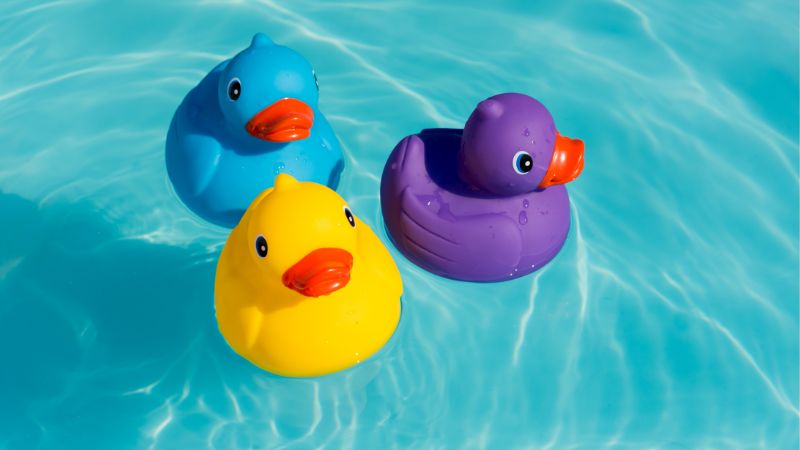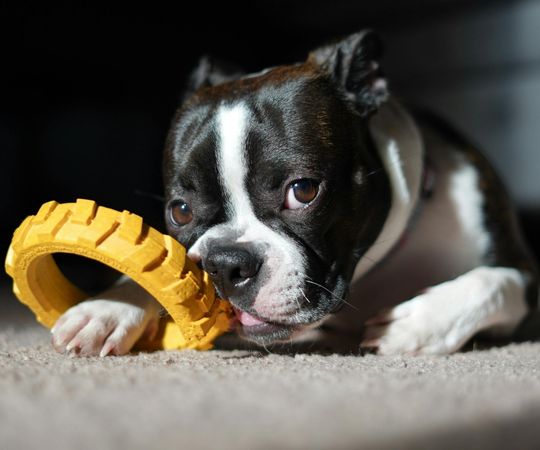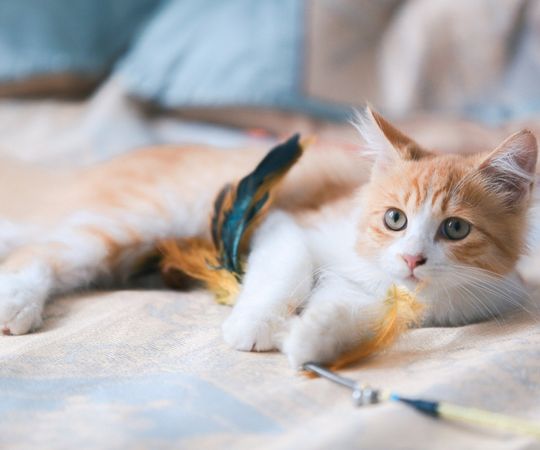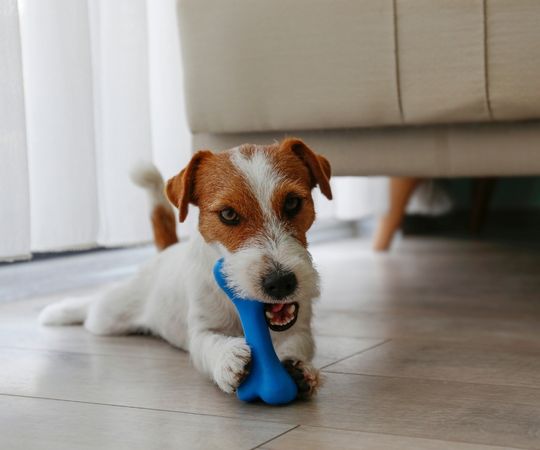When it comes to choosing the best toys for our furry companions, color might not be the first factor that comes to mind. However, the color of dog toys can significantly influence a dog’s interest and engagement during playtime.
Dogs perceive colors differently than humans, which means that what might look appealing to us may not have the same effect on them. In this guide, we will explore the best colors for dog toys to help you make informed choices for your beloved canine friend.

Are Dogs Color Blind?
You might have heard that dogs are color blind. This isn’t exactly true. Dogs do see colors, but they don’t see the world the same way people do.
Humans have three types of color receptors, called cones, in their eyes. This allows you to see a wide range of colors.
Your dog’s color vision is called dichromatic. Dogs only have two types of cones, so their color vision is more limited. Dogs are not color blind, but they do see a smaller range of colors than you do.
Here’s a simple table to show how some colors look to you versus your dog:
| Color | How You See It | How Your Dog Sees It |
| Red | Red | Dark brown or gray |
| Green | Green | Light yellow or gray |
| Blue | Blue | Blue |
| Yellow | Yellow | Yellow |
Why Color Matters in Dog Toys?
Choosing dog toys in the right color can make a real difference for your pet. Dogs see colors differently than humans, so picking the best shades helps make toys more fun and easier to find. The color of a toy can also affect how safe and visible it is during different kinds of play.
Enhancing Playtime through Color Contrast
The right color can keep playtime exciting and interactive for your dog. Toys that stand out against the background are much easier for dogs to find.
For example, a blue toy is more visible on green grass, while yellow toys pop on dark floors. If a toy blends in with the environment, your dog can get bored or lose interest because it’s hard to spot.
This contrast can capture their attention and keep them engaged during play, making playtime more enjoyable and interactive.
Increases Toy Visibility
Using the best colors isn’t just about fun—it’s also about keeping your dog safe. Toys in blue or yellow are easier to track during fetch or outdoor play, especially if you’re in areas with lots of grass, dirt, or sand.
Yellow toys stand out to your dogs, but they might blend into green grass or bushes. Blue toys work well outside because they don’t disappear visually against the grass or most surfaces.
Brightly colored toys can keep your dog’s attention longer and help reduce the chances that toys get lost. With better visibility, play sessions can be smoother and more fun for both you and your pet.
Best Color for Dog Toys

Dogs are beloved companions, and understanding their world helps us connect with them better. One fascinating aspect is their vision—specifically, the colors they can see. Let’s explore what colors dogs can really see.
Blue
Blue is highly visible in the eyes of dogs. This is because their eyes have two types of color receptors, and one of them is most sensitive to blue light. Blue toys show up against most backgrounds, whether you’re at the park or by the water.
For example, if you throw a blue thorn ball in the grass, your dog is likely to spot it faster than other colors. Blue is also easy for dogs to pick out on cloudy or overcast days when lighting isn’t great.
Many brands use blue as a main color for dog toys because it’s one of the shades dogs can see best. Blue isn’t just about making toys fun—it’s about making them more visible and easy for your pup to find if they’re dropped or thrown far.
Yellow
Yellow is also a color that dogs can see clearly. In their eyes, yellow appears much brighter compared to some other colors, like red.
If you pick out a yellow toy, your dog will have an easier time spotting it in grass, dirt, or sand. The combination of blue and yellow creates a sharp contrast that makes play more exciting for your dog.
When you’re shopping for toys or play gear, items with both blue and yellow can be especially good. You might see many popular toys come in these two colors for this reason.
Colors to Avoid for Dog Toys

Some colors just do not work well for dog toys. Dogs have trouble seeing certain shades, so these toys can get lost easily or be less fun for your pup.
Green
Green toys are hard for most dogs to see, especially outside. Green often looks dull or grayish to them, making it tough to spot in grass or gardens.
If you toss a green toy on the lawn, your dog might lose interest or spend too long searching. Try to avoid green toys for playtime, especially if you like playing fetch in the yard.
Red
Red is another tough color for dogs to notice. To them, red can appear more like brown or dark gray. When you buy a red toy, it might stand out to your eyes, but it can be almost invisible to your dog, especially on dark or earthy surfaces.
Red toys are easily lost in dirt, leaves, or wood chips at the park. Your dog might sniff around, only finding the toy by smell.
Skip red toys if your main goal is fast-paced games and easy searching.
Pink
Pink falls into a similar range as red and green on a dog’s color spectrum. What looks bright and pretty to humans might look muddy or gray to your dog. If you’re playing outdoors or anywhere with busy backgrounds, a pink toy might disappear fast.
Pink toys can work okay indoors if there is little color clutter, but they are still not ideal. They do not contrast well with most natural backgrounds, and your dog could ignore or lose the toy during playtime.
Choosing the Best Toy Colors for Your Dog
When you pick out toys for your dog, color matters more than you might think.
- Indoor Toys: For indoor play, bright blue and yellow toys are best for dogs because they contrast well with most flooring and furniture.
- Outdoor Toys: In outdoor settings, stick with blue toys for outdoor play, as they stand out against green grass and water.
- High Contrast for Older Dogs: As dogs age, their vision may decline. High-contrast colors like black and white can make toys easier for older dogs to see.
- Individual Preferences: While blue and yellow are generally the best choices, individual dogs may have unique preferences. Observe your dog’s reactions to different colors to determine what they enjoy the most.
By choosing toys in colors that dogs can see and distinguish clearly, you can enhance their play experience, making it more enjoyable and less frustrating.
Conclusion
Now that you know the best color for dog toys, it’s time to put that knowledge to good use! When you’re out shopping for toys, just remember: blue and yellow are your go-to colors. These shades really pop for your pup, making playtime way more fun and less frustrating.



